 Today, we’d like to tell you a little bit about the fashion of the mid-19th century. What did people wear? And why? What were fashion tendencies like? As you might know, the 1850s-1860s is the era of crinoline. Hoop skirts were so popular among European females of this period that it became ridiculous. But there were women who fought against cage crinolines and invented their own clothing styles, like Amelia Bloomer and her “bloomers”. Find out more in this article.
Today, we’d like to tell you a little bit about the fashion of the mid-19th century. What did people wear? And why? What were fashion tendencies like? As you might know, the 1850s-1860s is the era of crinoline. Hoop skirts were so popular among European females of this period that it became ridiculous. But there were women who fought against cage crinolines and invented their own clothing styles, like Amelia Bloomer and her “bloomers”. Find out more in this article.
The article is based on a video by Amanda Hallay, fashion historian
The 19th century had a very prudish and uptight attitude about sex. And by the 1850s, fashion, of course, responded with… the hoop skirt.
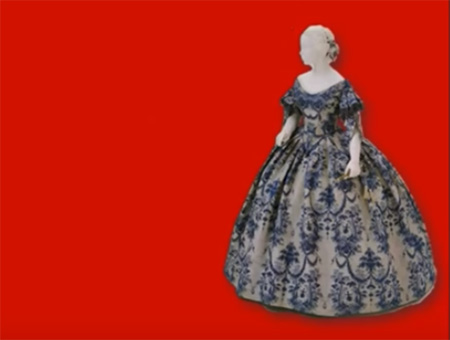
Many people think that hoop skirt was created as a hyperbole image of childbearing hips. But it’s a myth. Hoop skirts had absolutely nothing to do with women wanting to show they had childbearing hips. There is certainly not a scrap of evidence that suggests that this is what the hoop skirt was meant to suggest. The hoop skirt was the sartorial expression of Victorian prudery. It not only kept a lady's private parts at a safe distance from the outside world, it stopped men from getting too close to her.
This is a contemporaneous cartoon. This gentleman here is trying to shake hands with this lady but he can't get anywhere close to her hand because of her hoop skirt. So he's kind of balancing with his umbrella on that lamppost. Totally ridiculous but it makes the point.

Crinolines
Hoop skirts at the time were known as “crinolines”. In the 1830s and 1840s, the word “crinoline” was starting to be used, but these were simply stiff petticoats that incorporated horse hair (called “crin”) that gave skirts volume.
Yet by the 1850s, the “cage crinolines” were ubiquitous. And they looked like this.
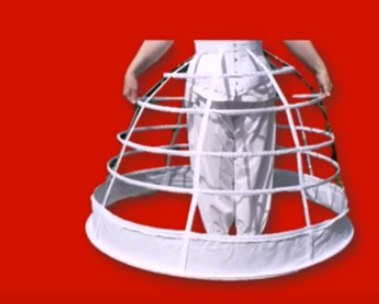
The shape of the crinoline changed a little between the 1850s and the 1860s.
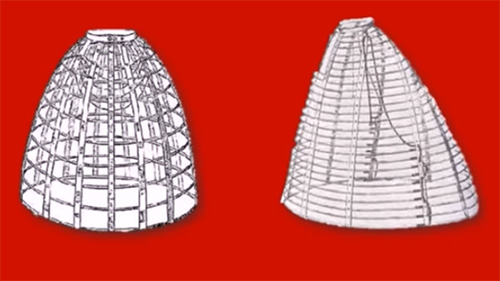
On the left: 1850s, cage crinoline. On the right: 1860s, elliptical cage crinoline
This is a dress from the 1850s, and here we have one from the 1860s.
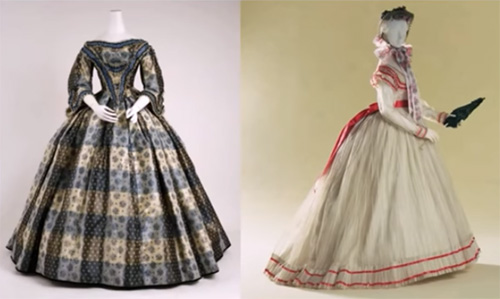
Everyone who was fashionable wore a hoop skirt, wore a crinoline – young women, children, even toddlers.
The attire of a 19th-century woman consisted of pantalettes, a shift, a tightly-laced corset, a crinoline, a petticoat, a high-necked dress, and a bonnet. The sleeves of a dress were wide, they are called “bishop sleeves”.
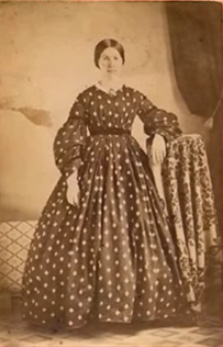
Low-shoulder gowns
In the mid-19th century, the erogenous zone was the shoulder. The one moment of sexy sartorial expressions a Victorian woman was allowed during the 1850s and 60s, was evening wear: ball gowns, evening dresses, etc. And as the erogenous zone was the shoulder, we see a lot of low-shouldered or off-the-shoulder gowns. They still have the crinoline there, but they are showing a lot of shoulder.
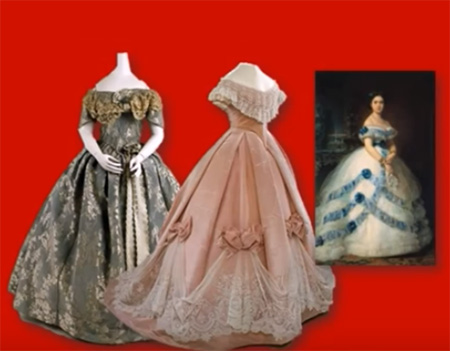
Pushing for dress reform
But restrictive and ridiculous as this moment in fashion was, there were women who were ready to push for dress reform. Amelia Bloomer being the most famous. She thought crinolines were quite ridiculous and restricted a woman's life, and so she and her followers did something shocking – they wore these sort of billowing harem pants with short or knee-length jackets. These billowing trousers were called “bloomers” in her honor.
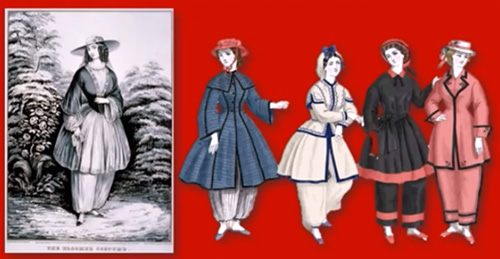
There were very few women who dressed like this. But still, there were women who were willing to make themselves extremely unpopular with the mainstream by pushing for dress reform.
Pagoda dress
The pagoda dress was a gown, fashioned upon tiers, and these tiers are called “flounces”. Actually, a pagoda is a tiered building found in Asia. This period marks the colonization by England, Spain, and Holland of various nations in Asia and Southeast Asia.
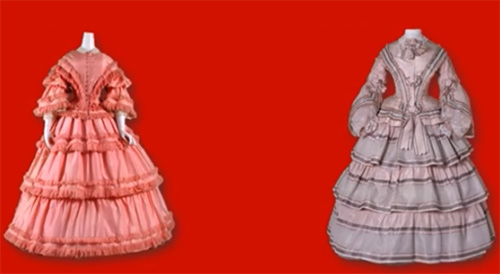
Even the sleeves of these dresses are made in tiers.
Paisley Shawl
A paisley pattern was so popular, every woman in the Victorian era owned a Paisley shawl. We can also find paisley design and paisley print on dresses. It wasn't actually initially called “paisley”. It became known as paisley because there is a town in Scotland that was particularly good at weaving paisley print and embroidering paisley and designing paisley. And the town is called Paisley.
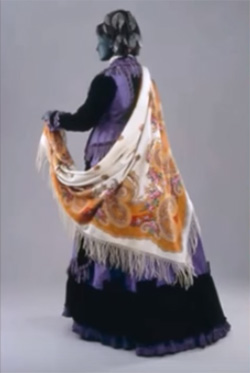
But the paisley design comes from India. This is an Indian and Persian motif.
Male facial fashion in the 1850s-60s
When we think of the Victorian men, we think of mustaches. These huge, extravagant, handlebar mustaches. Every man, from the mid-1800s until the end of the century, sported a mustache or whiskers – these huge fluffy sideburns.
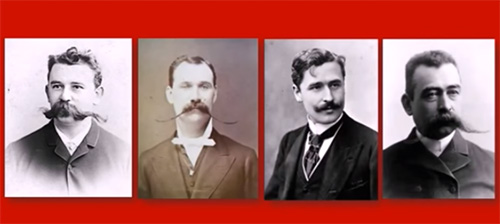
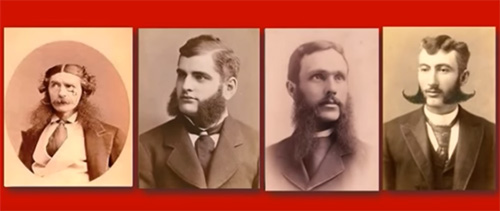
And this came from India. This is how Indian men did facial hair, with these big whiskers and mustaches.
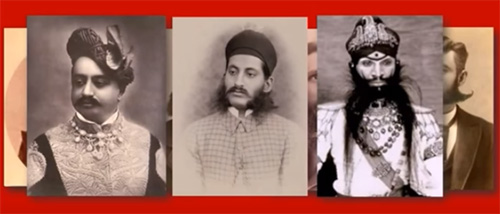
Male clothing in the mid-19th century
Actually, there's not much to say, not so many changes were made in this period. The frock coat would replace the tail coat for all occasions, other than evening.
Check this out: the 1850s-1890s. There's not much difference here.
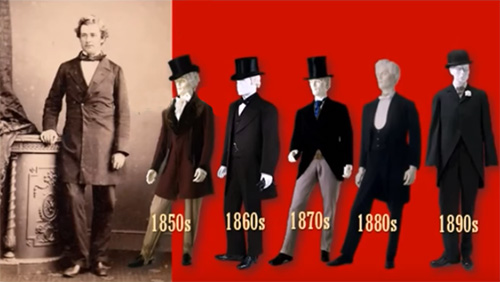
The 19th century is when men stopped doing fashion. Men's fashion has not essentially changed in almost 200 years.
(c)


